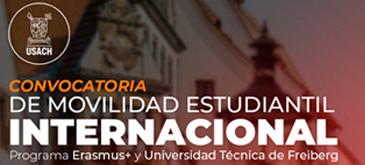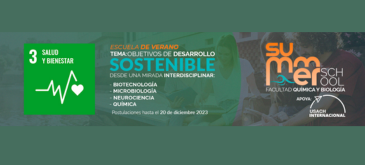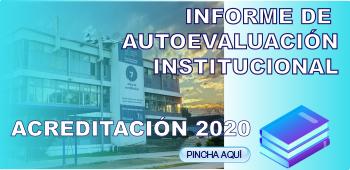Clase abierta y gratuita: Fármacos II y el nuevo escenario para los medicamentos y dispositivos médicos
Venegas Yazigi Diego A.

Abstract
Diego Venegas-Yazigi graduated in chemistry from the University of Chile’s Science Faculty, where he went on to obtain his PhD from the same university in 2001. He spent nearly two years with Prof. A.B.P. Lever at York University in Toronto, Canada, where he carried out much of his thesis work during his doctoral studies. He held a postdoctoral position for three years at the Chilean Centre for Multidisciplinary Materials Research (CIMAT), and then accepted an assistant professorship at the University of Chile from 2003 to 2007. Since 2008 he has held a full professorship at the University of Santiago, Chile. He is currently the leader of the Molecular Magnetism and Molecular Materials Laboratory (LM4). In this research group several different lines are developed. Our interest is centered on studying different Inorganic Materials and their magnetic, optical, and catalytic properties.
Initially, the area of molecular magnetism was focused on discrete systems (dimers, trimers) which were used as models to understand the magnetic exchange interactions. Then, chemists became more and more interested in designing systems with higher complexity, showing cooperative phenomena such as ferro- and ferrimagnetism. Other systems of interest were provided by discrete molecular entities exhibiting unusual behavior, such as the so-called Single Molecule Magnets (SMM). Due to their reduced size, these molecular entities show magnetic hysteresis at low temperature and quantum effects. They are now becoming one of the most essential objects in applied molecular magnetism as they can, in principle, store information at a molecular level. They can be, therefore, of interest in Molecular Nanomagnetism. Other exciting systems being designed and studied in our group are mixed-valence polyoxidometalates. These molecular entities can be functionalized to build hybrid organic-inorganic mixed-valence ligands to coordinate lanthanoid ions. These assemblies are of interest in magnetism and luminescence because the degree of mixed-valence in the polyoxidometalate fragment, plays a role in the observed magnetic and luminescent properties. Inorganic materials with catalytic properties are also studied, being the photocatalytic processes using inorganic nanocomposites the main object of our attention.
64.- Tamborelli, A.; López Mujica, M.; Sánchez-Velasco, O. A.; Hormazábal-Campos, C.; Pérez, E. G.; Gutierrez-Cutiño, M.; Venegas-Yazigi, D.; Dalmasso, P.; Rivas, G.; Hermosilla-Ibáñez, P. A New Strategy to Build Electrochemical Enzymatic Biosensors Using a Nanohybrid Material Based on Carbon Nanotubes and a Rationally Designed Schiff Base Containing Boronic Acid. Talanta 2024, 270 (November 2023), 125520. https://doi.org/10.1016/j.talanta.2023.125520.
63.- Soto-Donoso, N.; Favier, L.; Villalobos, S. F.; Paredes-García, V.; Bataille, T.; Marco, J. F.; Hlihor, R. M.; Le Fur, E.; Venegas-Yazigi, D. Lanthanum Hydroxychloride/Anatase Composite and Its Application for Effective UV-Light Driven Oxidation of the Emergent Water Contaminant Cetirizine. Chem. Eng. Res. Des. 2023, 196, 685–700. https://doi.org/10.1016/j.cherd.2023.06.032.
62.- Molina-Calderón, L.; Basualto-Flores, C.; Paredes-García, V.; Gutierrez-Cutiño, M.; Venegas-Yazigi, D. Magnetic Nanoadsorbent Functionalized with Aminophosphonic Acid for NdIII Ion Extraction from Aqueous Media. J. Mol. Liq. 2023, 384 (June), 122258. https://doi.org/10.1016/j.molliq.2023.122258.
61.- Cañón-Mancisidor, W.; Hermosilla-Ibáñez, P.; Spodine, E.; Paredes-García, V.; Gómez-García, C. J.; Venegas-Yazigi, D. Spin Frustrated Pyrazolato Triangular CuII Complex: Structure and Magnetic Properties, an Overview. Magnetochemistry 2023, 9 (6), 155. https://doi.org/10.3390/magnetochemistry9060155.
60.- Seguin, A. K.; Cruz, C.; Villafuerte, K.; Páez-Hernández, D.; Venegas-Yazigi, D.; Paredes-García, V. One-Dimensional Co II and Ni II Helical Coordination Polymers Exhibiting Zero-Field Splitting. Cryst. Growth Des. 2023, 23 (1), 77–86. https://doi.org/10.1021/acs.cgd.2c00728.
59.- Salazar, J.; Carmona, T.; Zacconi, F. C.; Venegas-Yazigi, D.; Cabello-Verrugio, C.; Il Choi, W.; Vilos, C. The Human Dermis as a Target of Nanoparticles for Treating Skin Conditions. Pharmaceutics 2022, 15 (1), 10. https://doi.org/10.3390/pharmaceutics15010010.
58.- Negrete-Vergara, C.; Álvarez-Alcalde, D.; Moya, S. A.; Paredes-García, V.; Fuentes, S.; Venegas-Yazigi, D. Selective Hydrogenation of Aromatic Nitro Compounds Using Unsupported Nickel Catalysts. ChemistrySelect 2022, 7 (20), 1–7. https://doi.org/10.1002/slct.202200220.
57.- Cruz, C.; Gonzalez, C.; Rubio, F.; Erices, J.; Wrighton-Araneda, K.; Cortés-Arriagada, D.; Venegas-Yazigi, D.; Audebrand, N.; Paredes-García, V. Chiral 1D Metal–Organic Materials Based on Cu(II) and Amino Acid Schiff Bases. Cryst. Growth Des. 2022, 22 (1), 237–250. https://doi.org/10.1021/acs.cgd.1c00877.
56.- Rozas, R.; Aspée, N.; Negrete-Vergara, C.; Venegas-Yazigi, D.; Gutiérrez-Cutiño, M.; Moya, S. A.; Zúñiga, C.; Cantero-López, P.; Luengo, J.; Gonzalez, R.; Romero, J.; Yáñez-S, M. Solvent Effects on the Molecular Structure of Isolated Lignins of Eucalyptus Nitens Wood and Oxidative Depolymerization to Phenolic Chemicals. Polym. Degrad. Stab. 2022, 201, 109973. https://doi.org/10.1016/j.polymdegradstab.2022.109973.
55.- Molina-Calderón, L.; Basualto-Flores, C.; Paredes-García, V.; Venegas-Yazigi, D. Advances of Magnetic Nanohydrometallurgy Using Superparamagnetic Nanomaterials as Rare Earth Ions Adsorbents: A Grand Opportunity for Sustainable Rare Earth Recovery. Sep. Purif. Technol. 2022, 299 (July), 121708. https://doi.org/10.1016/j.seppur.2022.121708.
54.- Muñoz-Becerra, K.; Wrighton-Araneda, K.; Le Fur, E.; Saillard, J.-Y.; Kahlal, S.; Cador, O.; Paredes-García, V.; Venegas-Yazigi, D. Non-Covalent Interactions in Hexanuclear Polyoxidometalates [VIV6B20O50H8]8−. An Experimental and Theoretical Approach. Polyhedron 2022, 211 (September 2021), 115553. https://doi.org/10.1016/j.poly.2021.115553.
53.- Carmona, T.; Marco, J. F.; Giménez-Marqués, M.; Cañón-Mancisidor, W.; Gutiérrez-Cutiño, M.; Hermosilla-Ibáñez, P.; Pérez, E. G.; Mínguez Espallargas, G.; Venegas-Yazigi, D. Functionalization Using Biocompatible Carboxylated Cyclodextrins of Iron-Based NanoMIL-100. Polyhedron 2021, 210 (October), 115509. https://doi.org/10.1016/j.poly.2021.115509.
52.- Cañón‐Mancisidor, W.; Paredes‐Castillo, G.; Hermosilla‐Ibáñez, P.; Venegas‐Yazigi, D.; Cador, O.; Le Guennic, B.; Pointillart, F. Role of the Templating Heteroatom on Both Structural and Magnetic Properties of POM‐Based SIM Lanthanoid Complexes. Eur. J. Inorg. Chem. 2021, 2021 (45), 4596–4609. https://doi.org/10.1002/ejic.202100670.
51.- Cañón-Mancisidor, W.; Hermosilla-Ibáñez, P.; Spodine, E.; Paredes-García, V.; Gómez-García, C. J.; Espallargas, G. M.; Venegas-Yazigi, D. Slow Relaxation of the Magnetization on Frustrated Triangular Fe III Units with S = 1 / 2 Ground State: The Effect of the Highly Ordered Crystal Lattice and the Counteranions. Cryst. Growth Des. 2021, 21 (11), 6213–6222. https://doi.org/10.1021/acs.cgd.1c00640.
50.- Baldo, B.; Bataille, T.; Venegas-Yazigi, D.; Audebrand, N.; Paredes-García, V. Heterometallic Coordination Polymers Based on CuII/LnIII Cations. Solid-State and Magnetic Characterization. J. Solid State Chem. 2021, 303 (July), 122482. https://doi.org/10.1016/j.jssc.2021.122482.
49.- Mujica, M. L.; Sotomayor‐Santander, I.; Hermosilla‐Ibáñez, P.; Oyarzun‐Ampuero, F.; Rodríguez, M. C.; Rivas, G. A.; Venegas‐Yazigi, D.; Bollo, S. MWCNT‐Organoimido Polyoxomolybdate Hybrid Material: Analytical Applications for Amperometric Sensing of Hydrogen Peroxide. Electroanalysis 2021, 33 (9), 2105–2114. https://doi.org/10.1002/elan.202100149.
48.- Seguin, A. K.; Wrighton-Araneda, K.; Cortés-Arriagada, D.; Cruz, C.; Venegas-Yazigi, D.; Paredes-García, V. A New CuII-Dinuclear Paddlewheel Complex. Structural and Electronic Properties. J. Mol. Struct. 2021, 1224, 129172. https://doi.org/10.1016/j.molstruc.2020.129172.
47.- Santana, P. A.; Castillo, C. A.; Michea, S. A.; Venegas-Yazigi, D.; Paredes-García, V. Co 0 Superparamagnetic Nanoparticles Stabilized by an Organic Layer Coating with Antimicrobial Activity. RSC Adv. 2020, 10 (57), 34712–34718. https://doi.org/10.1039/D0RA07017C.
46.- Zapata-Lizama, M.; Hermosilla-Ibáñez, P.; Venegas-Yazigi, D.; Mínguez Espallargas, G.; Queiroz Maia, L. J.; Gasparotto, G.; De Santana, R. C.; Cañón-Mancisidor, W. A Systematic Study of the Optical Properties of Mononuclear Hybrid Organo–Inorganic Lanthanoid Complexes. Inorg. Chem. Front. 2020, 7 (17), 3049–3062. https://doi.org/10.1039/D0QI00232A.
45.- Cruz, C.; Vega Carvallo, A. I.; Spodine, E.; Escuer, A.; Marco, J. F.; Menéndez, N.; Venegas-Yazigi, D.; Paredes-García, V. New Highly Charged Iron(III) Metal-Organic Cube Stabilized by a Bulky Amine. ACS Omega 2020, 9 (Iii). https://doi.org/10.1021/acsomega.0c02420.
44.- Cruz, C.; Rubio, F.; Venegas-Yazigi, D.; Audebrand, N.; Calers, C.; Spodine, E.; Paredes-García, V. Toward a Rational Design of 3d-4f Heterometallic Coordination Polymers Based on Mixed Valence Copper Centers. Cryst. Growth Des. 2019, 19 (12), 7055–7066. https://doi.org/10.1021/acs.cgd.9b00816.
43.- Cañón-Mancisidor, W.; Zapata-Lizama, M.; Hermosilla-Ibáñez, P.; Cruz, C.; Venegas-Yazigi, D.; Mínguez Espallargas, G. Hybrid Organic-Inorganic Mononuclear Lanthanoid Single Ion Magnets. Chem. Commun. 2019, 55 (99), 14992–14995. https://doi.org/10.1039/c9cc07868a.
42.- Hermosilla-Ibáñez, P.; Wrighton-Araneda, K.; Scarpetta-Pizo, L.; Cañón-Mancisidor, W.; Gutierrez-Cutiño, M.; Le Fur, E.; Paredes-García, V.; Venegas-Yazigi, D. The Origin of the Electronic Transitions of Mixed Valence Polyoxovanadoborates [V 12 B 18 O 60 ]: From an Experimental to a Theoretical Understanding. New J. Chem. 2019, 43 (45), 17538–17547. https://doi.org/10.1039/C9NJ02549A.
41.- Hermosilla-Ibáñez, P.; Wrighton-Araneda, K.; Cañón-Mancisidor, W.; Gutiérrez-Cutiño, M.; Paredes-García, V.; Venegas-Yazigi, D. Substitution Effect on the Charge Transfer Processes in Organo-Imido Lindqvist-Polyoxomolybdate. Molecules 2018, 24 (1), 44. https://doi.org/10.3390/molecules24010044.
40.- Cruz, C.; Spodine, E.; Audebrand, N.; Venegas-Yazigi, D.; Paredes-Garciá, V. Structural Versatility of 3 D-CeIIIHeterometallic Coordination Polymers Using CoIIor CuII. Cryst. Growth Des. 2018, 18 (9), 5155–5165. https://doi.org/10.1021/acs.cgd.8b00590.
39.- Baldo, B.; Rubio, F.; Flores, E.; Vega, A.; Audebrand, N.; Venegas-Yazigi, D.; Paredes-García, V. Ni 2 [LnCl 6 ] (Ln = Eu II , Ce II , Gd II ): The First Ln II Compounds Stabilized in a Pure Inorganic Lattice. Chem. Commun. 2018, 54 (54), 7531–7534. https://doi.org/10.1039/C7CC09921E.
38.- de Santana, R. C.; Fuentealba, P. A.; Maia, L. J. Q.; Paredes-García, V.; Aravena, D.; Venegas-Yazigi, D.; Manzur, J.; Spodine, E. Solid State Photoluminescence Studies of [EuL n H 2 (NO 3 ) 3 ](H 2 O) x Macrocyclic Complexes with Schiff Base Ligands. J. Lumin. 2018, 203 (3), 7–15. https://doi.org/10.1016/j.jlumin.2018.06.022.
37.- Chi-Durán, I.; Enríquez, J.; Manquian, C.; Wrighton-Araneda, K.; Cañon-Mancisidor, W.; Venegas-Yazigi, D.; Herrera, F.; Singh, D. P. PH-Controlled Assembly of 3D and 2D Zinc-Based Metal-Organic Frameworks with Tetrazole Ligands. ACS Omega 2018, 3 (1), 801–807. https://doi.org/10.1021/acsomega.7b01792.
36.- Fuentealba, P.; Cortes, C.; Manzur, J.; Paredes-García, V.; Venegas-Yazigi, D.; Silva, I. D. A.; de Santana, R. C.; Magon, C. J.; Spodine, E. Magnetic Behaviour of Bimetallic Layered Phases M′ 0.2 Mn 0.8 PS 3 ·0.25 H 2 O (M′ = Zn II , Cu II , Ni II , Co II ). Dalt. Trans. 2017, 46 (41), 14373–14381. https://doi.org/10.1039/C7DT03249H.
35.- Cruz, C.; Spodine, E.; Venegas-Yazigi, D.; Paredes-García, V. Cu(II)–Gd(III) 2D-Coordination Polymer Based on Two Different Organic Linkers. Polyhedron 2017, 136, 117–124. https://doi.org/10.1016/j.poly.2017.02.002.
34.- Hermosilla-Ibáñez, P.; Wrighton-Araneda, K.; Prado, G.; Paredes-García, V.; Pizarro, N.; Vega, A.; Venegas-Yazigi, D. The First Re I Organometallic Complex with an Organoimido-Polyoxometalate Ligand. Dalt. Trans. 2017, 46 (26), 8611–8620. https://doi.org/10.1039/C7DT01633F.
33.- Fuentealba, P.; Paredes-Garcia, V.; Venegas-Yazigi, D.; Silva, I. D. A.; Magon, C. J.; Costa de Santana, R.; Audebrand, N.; Manzur, J.; Spodine, E. Magnetic Properties of Composites Based on the Intercalation of Zn II and Cu II Bimetallic Macrocyclic Complexes in the MnPS 3 Phase. RSC Adv. 2017, 7 (53), 33305–33313. https://doi.org/10.1039/C7RA05089E.
32.- López, D.; Márquez, A.; Gutiérrez-Cutiño, M.; Venegas-Yazigi, D.; Bustos, R.; Matiacevich, S. Edible Film with Antioxidant Capacity Based on Salmon Gelatin and Boldine. LWT - Food Sci. Technol. 2017, 77, 160–169. https://doi.org/10.1016/j.lwt.2016.11.039.
31.- Muñoz-Becerra, K.; Aravena, D.; Ruiz, E.; Spodine, E.; Soto-Donoso, N.; Paredes-García, V.; Venegas-Yazigi, D. Models to Predict the Magnetic Properties of Single- and Multiple-Bridged Phosphate Cu II Systems: A Theoretical DFT Insight. Inorg. Chem. Front. 2017, 4 (3), 509–520. https://doi.org/10.1039/C6QI00394J.
30.- Cruz, C.; Spodine, E.; Vega, A.; Venegas-Yazigi, D.; Paredes-García, V. Novel 3d/4f Metal Organic Networks Containing Co II Chiral Chains. Cryst. Growth Des. 2016, 16 (4), 2173–2182. https://doi.org/10.1021/acs.cgd.5b01843.
29.- Aravena, D.; Venegas-Yazigi, D.; Ruiz, E. Single-Molecule Magnet Properties of Transition-Metal Ions Encapsulated in Lacunary Polyoxometalates: A Theoretical Study. Inorg. Chem. 2016, 55 (13), 6405–6413. https://doi.org/10.1021/acs.inorgchem.6b00145.
28.- Aravena, D.; Venegas-Yazigi, D.; Ruiz, E. Exchange Interactions on the Highest-Spin Reported Molecule: The Mixed-Valence Fe42 Complex. Sci. Rep. 2016, 6 (April), 23847. https://doi.org/10.1038/srep23847.
27.- Castillo, C.; Seguin, K.; Aguirre, P.; Venegas-Yazigi, D.; Viegas, A. D. C.; Spodine, E.; Paredes-Garcia, V. Nickel Nanocomposites: Magnetic and Catalytic Properties. RSC Adv. 2015, 5 (77), 63073–63079. https://doi.org/10.1039/C5RA09622G.
26.- Venegas-Yazigi, D.; Spodine, E.; Saldias, M.; Vega, A.; Paredes-García, V.; Calvo, R.; Santana, R. C. De. 1D Magnetic Interactions in Cu II Oxovanadium Phosphates (VPO), Magnetic Susceptibility, DFT, and Single-Crystal EPR. Inorg. Chem. 2015, 54 (8), 3805–3814. https://doi.org/10.1021/ic503045d.
25.- Fuentealba, P.; Cortés, C.; Audebrand, N.; Le Fur, E.; Paredes-García, V.; Venegas-Yazigi, D.; Manzur, J.; Spodine, E. First Copper( Ii ) Phase M′0.2Mn 0.8 PS 3 ·0.25H 2 O and Analogous M′ = Co II , Ni II and Zn II Materials Obtained by Microwave Assisted Synthesis. Dalt. Trans. 2015, 44 (28), 12493–12496. https://doi.org/10.1039/C5DT01540E.
24.- Hermosilla-Ibáñez, P.; Muñoz-Becerra, K.; Paredes-García, V.; Fur, E.; Spodine, E.; Venegas-Yazigi, D. Structural and Electronic Properties of Polyoxovanadoborates Containing the [V12B18O60] Core in Different Mixed Valence States. Inorganics 2015, 3 (3), 309–331. https://doi.org/10.3390/inorganics3030309.
23.- Muñoz-Becerra, K.; Hermosilla-Ibáñez, P.; Le Fur, E.; Cador, O.; Paredes-García, V.; Spodine, E.; Venegas-Yazigi, D. First Non-Centrosymmetric Deca-Vanadoborate with Borate Vacancies, Self-Assembled around a 1,3-Propanediammonium Cation. Cryst. Growth Des. 2015, 15, 2561–2564. https://doi.org/10.1021/acs.cgd.5b00102.
22.- Hermosilla-Ibáñez, P.; Costamagna, J.; Vega, A.; Paredes-García, V.; Le Fur, E.; Spodine, E.; Venegas-Yazigi, D. Coordination Interactions in the Crystalline Lattice of Alkaline Ions with the Polyoxometalate [V12B18O60H6]10− Ligand. J. Coord. Chem. 2014, 67 (23–24), 3940–3952. https://doi.org/10.1080/00958972.2014.960407.
21.- Hermosilla-Ibáñez, P.; Costamagna, J.; Vega, A.; Paredes-García, V.; Garland, M. T.; Le Fur, E.; Spodine, E.; Venegas-Yazigi, D. Protonated Diamines as Linkers in the Supramolecular Assemblies Based on the [V12B18O60H6] Polyoxovanadoborate Anion. J. Struct. Chem. 2014, 55 (8), 1453–1465. https://doi.org/10.1134/S0022476614080125.
20.- Fuentealba, P.; Serón, L.; Sánchez, C.; Manzur, J.; Paredes-Garcia, V.; Pizarro, N.; Cepeda, M.; Venegas-Yazigi, D.; Spodine, E. Macrocyclic Zn II and Cu II Complexes as Guests of the Hybrid Composites Based on the Layered MnPS 3 Phase. Comparison of Spectroscopic Properties. J. Coord. Chem. 2014, 67 (October), 3894–3908. https://doi.org/10.1080/00958972.2014.968145.
19.- Hermosilla-Ibáñez, P.; Cañon-Mancisidor, W.; Costamagna, J.; Vega, A.; Paredes-García, V.; Garland, M. T.; Le Fur, E.; Cador, O.; Spodine, E.; Venegas-Yazigi, D. Crystal Lattice Effect on the Quenching of the Intracluster Magnetic Interaction in [V12B18O60H6](10-) Polyoxometalate. Dalton Trans. 2014, 43 (37), 14132–14141. https://doi.org/10.1039/c4dt01561d.
18.- Borisova, N. E.; Kostin, A.; Magdesieva, T. V.; Reshetova, M. D.; Nikitin, O.; Paredes-García, V.; Garland, M. T.; Hermosilla-Ibáñez, P.; Cañon-Mancisidor, W.; Rodionov, A.; Venegas-Yazigi, D.; Spodine, E. Solvent Switchable CuII Complexes. New J. Chem. 2014, 38 (2), 709. https://doi.org/10.1039/c3nj00722g.
17.- Auguste, S.; Alonzo, V.; Bataille, T.; Le Pollès, L.; Cañón-Mancisidor, W.; Venegas-Yazigi, D.; Le Fur, E. Lithium Vanadyl Oxalatophosphite: Influence of the Water Content on the Crystal Structures and the Dehydration Scheme. J. Solid State Chem. 2014, 211, 212–218. https://doi.org/10.1016/j.jssc.2013.12.019.
16.- Paredes-Garcia, V.; Cruz, C.; Toledo, N.; Denardin, J.; Venegas-Yazigi, D.; Castillo, C.; Spodine, E.; Luo, Z. Effect of the Different Synthetic Parameters on the Morphology and Magnetic Properties of Nickel Nanoparticles. New J. Chem. 2014, 38 (2), 837. https://doi.org/10.1039/c3nj01040f.
15.- Cañon-Mancisidor, W.; Gómez-García, C. J.; Espallargas, G. M.; Vega, A.; Spodine, E.; Venegas-Yazigi, D.; Coronado, E. Structural Re-Arrangement in Two Hexanuclear CuII Complexes: From a Spin Frustrated Trigonal Prism to a Strongly Coupled Antiferromagnetic Soluble Ring Complex with a Porous Tubular Structure. Chem. Sci. 2014, 5 (1), 324. https://doi.org/10.1039/c3sc52628c.
14.- Paredes-García, V.; Rojas, I.; Madrid, R.; Vega, A.; Navarro-Moratalla, E.; Cañón-Mancisidor, W.; Spodine, E.; Venegas-Yazigi, D. Structural and Magnetic Characterization of the Tridimensional Network [Fe(HCO2)3]N·nHCO2H. New J. Chem. 2013, 37 (7), 2120. https://doi.org/10.1039/c3nj00023k.
13.- VALENCIA, P.; MANZUR, J.; GARCIA, A. M.; PAREDES-GARCIA, V.; CARDOSO-GIL, R.; SCHNELLE, W.; KNIEP, R.; FUENTEALBA, P.; VENEGAS-YAZIGI, D.; SPODINE, E. MAGNETIC BEHAVIOR OF LAMELLAR MnPS3 AND CdPS3 COMPOSITES WITH A PARAMAGNETIC MANGANESE(III) MACROCYCLIC GUEST. J. Chil. Chem. Soc. 2013, 58 (4), 1952–1956. https://doi.org/10.4067/S0717-97072013000400008.
12.- Pot, O. N. E.; Synthesis, S.; Organic, O. F.; Coated, A.; Iron, M. ONE POT SOLVOTHERMAL SYNTHESIS OF ORGANIC ACID COATED MAGNETIC IRON OXIDE D = b Cos Q. J. Chil. Chem. Soc. 2013, 4 (4), 2011–2015.
11.- Hamchaoui, F.; Alonzo, V.; Venegas-Yazigi, D.; Rebbah, H.; Le Fur, E. ChemInform Abstract: Six Novel Transition-Metal Phosphite Compounds, with Structure Related to Yavapaiite: Crystal Structures and Magnetic and Thermal Properties of A I [M III (HPO 3 ) 2 ] (A: K, NH 4 , Rb and M: V, Fe). ChemInform 2013, 44 (17), no-no. https://doi.org/10.1002/chin.201317018.
10.- PAREDES-GARCÍA, V.; TOLEDO, N.; DENARDIN, J.; VENEGAS-YAZIGI, D.; CRUZ, C.; SPODINE, E.; LUO, Z. ONE POT SOLVOTHERMAL SYNTHESIS OF ORGANIC ACID COATED MAGNETIC IRON OXIDE NANOPARTICLES. J. Chil. Chem. Soc. 2013, 58 (4), 2011–2015. https://doi.org/10.4067/S0717-97072013000400023.
9.- Cancino, P.; Spodine, E.; Paredes-García, V.; Venegas-Yazigi, D.; Vega, A. The Layered Structure of Poly[[Hexaaqua(Μ4-Benzene-1,2,4,5-Tetracarboxylato)Dicopper(II)] Tetrahydrate]. Acta Crystallogr. C. 2013, 69 (Pt 11), 1344–1347. https://doi.org/10.1107/S0108270113026620.
8.- VALENCIA, P.; MANZUR, J.; GARCIA, A. M.; PAREDES-GARCIA, V.; CARDOSO-GIL, R.; SCHNELLE, W.; KNIEP, R.; FUENTEALBA, P.; VENEGAS-YAZIGI, D.; SPODINE, E. MAGNETIC BEHAVIOR OF LAMELLAR MnPS3 AND CdPS3 COMPOSITES WITH A PARAMAGNETIC MANGANESE(III) MACROCYCLIC GUEST. J. Chil. Chem. Soc. 2013, 58 (4), 1952–1956. https://doi.org/10.4067/S0717-97072013000400008.
7.- Silva-Galaz, C.; Saldias, M.; Garland, M. T.; Vega, A.; Paredes-García, V.; Spodine, E.; Venegas-Yazigi, D. K3[Fe3.26V0.74(OH)O(PO4)4(H2O)2]·2H2O: A Synthetic Leucophosphite. J. Coord. Chem. 2013, 66 (10), 1830–1836. https://doi.org/10.1080/00958972.2013.791685.
6.- Silva-Galaz, C.; Saldías, M.; Freire, E.; Baggio, R.; Le Fur, E.; Paredes-Garcia, V.; Spodine, E.; Venegas-Yazigi, D. Catena-(Bis((1,10-Phenanthroline-N,N′)-Copper(II)) Hydroxy-Bis(Phosphato)-Tris(Dioxo-Vanadium(v))): A Polymorphic Phase Driven by Disorder. J. Mol. Struct. 2013, 1051, 205–210. https://doi.org/10.1016/j.molstruc.2013.08.005.
5.- Cañon-Mancisidor, W.; Spodine, E.; Paredes-Garcia, V.; Venegas-Yazigi, D. Theoretical Description of the Magnetic Properties of Μ3-Hydroxo Bridged Trinuclear Copper(II) Complexes. J. Mol. Model. 2013, 19 (7), 2835–2844. https://doi.org/10.1007/s00894-012-1696-5.
4.- Paredes-García, V.; Santana, R. C.; Madrid, R.; Vega, A.; Spodine, E.; Venegas-Yazigi, D. Unusual Conformation of a Dinuclear Paddle Wheel Copper(II) Complex. Synthesis, Structural Characterization and EPR Studies. Inorg. Chem. 2013, 52 (15), 8369–8377. https://doi.org/10.1021/ic3027804.
3.- Baldo, B.; Cruz, C.; Venegas-Yazigi, D.; Vega, A.; Paredes-García, V. Catena -Poly[Tris(μ 3 -Acetylacetonato)Nickelate(II)Sodium(I)]. Acta Crystallogr. Sect. C Cryst. Struct. Commun. 2013, 69 (5), 506–508. https://doi.org/10.1107/S0108270113009797.
2.- Hamchaoui, F.; Alonzo, V.; Venegas-Yazigi, D.; Rebbah, H.; Le Fur, E. Six Novel Transition-Metal Phosphite Compounds, with Structure Related to Yavapaiite: Crystal Structures and Magnetic and Thermal Properties of AI[MIII(HPO3)2] (A=K, NH4, Rb and M=V, Fe). J. Solid State Chem. 2013, 198, 295–302. https://doi.org/10.1016/j.jssc.2012.10.007.
1.- Venegas-Yazigi, D.; Muñoz, K.; Saldías, M.; Valdés de la Barra, K.; Vega, A.; Paredes-García, V.; Gómez-García, C. J.; Le Fur, E.; Cañón-Mancisidor, W.; Spodine, E. Magnetic Properties of Vanadium(IV)-Based Extended Systems: [(VO)3(μ-PO4)2(2,2′-Bpy)(μ-OH2)]·1/3H2O and (VO)2H4P2O9. Inorganica Chim. Acta 2013, 395 (Iv), 176–180. https://doi.org/10.1016/j.ica.2012.10.024.
In 2007 he was awarded by the Chilean Academy of Sciences, being part of the “Ciencia de Frontera” scientists’ group.
At the present several research lines are developed, centered in Inorganic Materials and their magnetic, optic, and photocatalytic properties.
ORCID: 0000-0001-7816-2841
SCOPUS ID: 6506133767
Proyectos Nacionales e Internacionales:
|
Project |
Years |
Role |
|
IRP CoopIC CNRS France « Cooperation in Inorganic Chemistry » |
2022-2026 |
Main Researcher Head of Line at USACH |
|
ECOS 200027 ANID-CNRS Lanthanide complexes based on hybrid inorganic-organic ligands for nanomagnets |
2021-2023 |
Co-Researcher |
|
LIA-M3 1027 «Laboratoire Internationale Associé Matériaux Moléculaire Multifonctionnels ». CNRS, Francia/CONICYT, Chile. Head of Research Line. |
2017-2021 |
Main Researcher Head of Line at USACH |
|
FONDECYT 1201249. “Electronic properties of coordination compounds based on functionalized mixed-valence polyoxometalates coordinated to lanthanide ions”. |
2020-2023 |
Main Researcher |
|
FONDECYT 1161255. “Optical and magnetic properties of functionalized and non-functionalized mixed valence polyoxometalates. Towards charge transfer and delocalization phenomena”. |
2016-2019 |
Main Researcher |
|
FONDECYT 1170887. “Homo- and Heterometallic Coordination Polymers: Structure and Functionality”. |
2017-2020 |
Co-Researcher |
|
FONDECYT 1160106. “Composites with Lanthanide (III) Species based on Bimetallic Phases Mx´Mn1-xPS3. Spectroscopic and Magnetic Properties.” |
2016-2019 |
Co-Researcher |
|
Financiamiento Basal para Centros de Excelencia. AFB180001 “Center for the Development of Nanoscience and Nanotechnology, CEDENNA”. |
2020-2022 |
Main Researcher, Head of Line 3. |
|
Financiamiento Basal para Centros de Excelencia. FB0807 “Center for the Development of Nanoscience and Nanotechnology, CEDENNA”. |
2015-2020 |
Main Researcher, Head of Line 3. |
|
Anillos en Ciencia y Tecnología. “Materiales Inorgánicos Polifuncionales en Base a Metales Chilenos Estratégicos- IPMaG” ACT1404. |
2015-2018 |
Main Researcher |
|
CORFO 13IDL2-25356. “Filtros regenerables para la sorción de contaminantes". |
2013-2015 |
Director |
|
CORFO 14IDL2-29709. “Optimización de la relación eficiencia-costo de nano-microestructuras de TiO2 dopadas, soportadas para la foto-degradación de pesticidas que contaminan cuencas de ríos chilenos”. |
2015-2016 |
Director |
|
EQM-140060. FONDEQUIP National Project for Scientific Equipment, FONDEQUIP. “Cryostat, Goniometer and double resonance cavity for an X-Band EPR”. |
2014-2015 |
Main Researcher |
|
FONDECYT 1130643. “New Polyfunctional 3d-4f Metal Organic Materials: Magnetic and Optical Properties”. |
2013-2016 |
Co-Researcher |
|
LIA-MIF 836 «Laboratoire Internationale Associé Matériaux Inorganique Fonctionnels ». CNRS, Francia/CONICYT, Chile. Jefe de Línea de Magnetismo Molecular. |
2009-2016 |
Main Researcher Head of Line at USACH |
|
FONDECYT 1120004. “Molecular Magnetism Studies on Polyoxometalates Based on BVO, BVPO and BMOPO Systems”. |
2012-2015 |
Main Researcher. |
|
FONDECYT 1120001. “Nanostructured Materials: MPS3 Composites Based on Intercalated Macrocyclic and Acyclic Complexes”. |
2012-2015 |
Co-Researcher. |
|
ECOS-CONICYT C08E02. “Optimized Electronic Description Of Functionalized Inorganic Materials”. |
2009-2011 |
Main Researcher |
|
Financiamiento Basal para Centros de Excelencia. FB0807 “Center for the Development of Nanoscience and Nanotechnology, CEDENNA”. |
2009-2014 |
Main Researcher. |
|
FONDECYT 1090477. “Structural and Magnetic Study of Polymetallic Systems with Aminoacids as Carboxylate-Based Ligands”. |
2009-2012 |
Co-Researcher. |
|
DFG-CONICYT. “Functionalized Inorganic Frameworks Towards New Materials with Magnetic Properties” Max Planck Institut für Chemische Physik fester Stoffe, Dresden, Germany. |
2009-2010 |
Co-Researcher. |
|
FONDECYT 1080316. “Molecular Magnetism in Inorganic Materials Based on Extended Organo-Inorganic Systems”. |
2008-2011 |
Main Researcher. |
Proyectos Internos USACH:
|
Project |
Year |
Role |
|
Proyecto de Financiamiento Postdoctoral DICYT-USACH 022142VY |
2021 |
Principal Investigator |
|
Proyecto de Financiamiento Postdoctoral DICYT-USACH 022042VY |
2020 |
Principal Investigator |
|
Proyecto de Financiamiento Postdoctoral DICYT-USACH 021842VY |
2018 |
Principal Investigator |
|
Proyecto de Financiamiento Postdoctoral DICYT-USACH 021742VY |
2017 |
Principal Investigator |
|
DICYT Asociativo Recubrimientos Bioactivos para Alimentos 2014-2016 |
2014 |
Co-Researcher |
|
Proyecto de Financiamiento Postdoctoral DICYT-USACH |
2016 |
Principal Investigator |
|
"Estudio teórico de propiedades magnéticas de sistemas de alta nuclearidad e imanes unimoleculares", código 021542VY _INTEXCELEN. MECESUP-VRIDEI-USACH. |
2015 |
Principal Investigator |
|
DICYT-USACH. Research Stay in March 2013 at the Instituto de Ciencia Molecular, Valencia, Spain. |
2013 |
Principal Investigator |
|
DICYT-USACH. Research Stay in June 2011 at the Lomonosov University, Moscow, Russia. |
2011 |
Principal Investigator. |
|
DICYT-USACH. Research Stay at the Ecole National Supérieure de Chimie de Rennes, Rennes, France. |
2010 |
Principal Investigator. |
|
DICYT-USACH. Research Stay at the Max Planck Institut für Chemische Physik fester Stoffe, Dresden, Germany. |
2009 |
Principal Investigator. |









